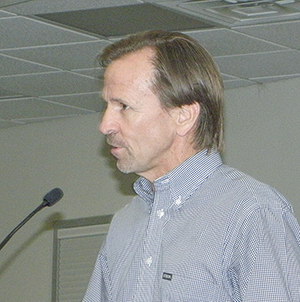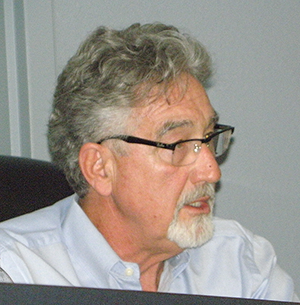By Linda Bentley | May 4, 2016
New creative concept to conserve 4,000 acres
Although USACE would ultimately need to approve the MB, Betts said the meetings have gone very well and they are very optimistic
CAVE CREEK – Call to the Public brought Bob Morris, a member of the Water Advisory Committee, to the podium to condemn staff’s recommendation for a 14 percent hike in water rates as well as spending $50,000 for a water rate study, which he called premature.
He said staff has no objectives and still can’t certify the town’s utilities are efficiently run.
He said, “I do not support a study … garbage in garbage out.”
Paul Diefenderfer told council the bike lanes may be a “source of angst” for many but he thanked the town for making it safer for people like him.
 Steve Betts
Steve Betts
Steve Betts, who was brought on board to help the town come up with a way to conserve the approximately 4,000 acres of state land annexed into the town as open space, made a presentation to update citizens on a series of meetings that have been held with the deputy state land commissioner and his staff at the Arizona State Land Department (ASLD).
Betts said those discussions have led to exploring the possibility of forming a Mitigation Bank (MB) for the purpose of conserving those lands.
He said, “As a resident, I’m very excited about this.”
Explaining the basic concept, which Betts commented was “not reinventing the wheel,” the ASLD would transfer the 4,000 acres into a MB approved by the U.S. Army Corps of Engineers (USACE).
The MB would then receive mitigation credits that could be sold to developers of other parcels of state trust lands downstream (Desert Ridge area) that require Section 404 permits from the USACE.
The revenue from the sale of those credits would go toward the payment/reimbursement for the cost of the land put into the MB and for restoration of those lands.
The town would take on the operation and maintenance of the lands, or sub it out, and allow for recreational uses consistent with the conservation values of the land, similar to Spur Cross.
The MB concept would allow the ASLD to receive full value for the trust land, consistent with their legal fiduciary responsibility, while providing the ability to expedite development/sales of valuable lands downstream in the Desert Ridge area with 404 permits.
It would also honor the spirit of the original annexation development agreement with the town.
If the MB concept can be achieved, Betts said the town will have the ability to control the 4,000 acres of state trust land for conservation and recreation without having to purchase the land at full value.
Although USACE would ultimately need to approve the MB, Betts said the meetings have gone very well and they are very optimistic.
Betts said dialogue will continue with ASLD and the next steps involve the Arizona Attorney General’s Office drafting an intergovernmental agreement (IGA) between the town and ASLD to conduct a biological assessment at a cost of approximately $20,000, which would be split 50-50.
Betts believes the lands should be very eligible.
While serving on Gov. Doug Ducey’s transition team, Betts said he spoke to previous land commissioners and found the MB concept was something the ASLD has been considering for years but never had the time or expertise to pursue it.
During public comment, Anna Marsolo said if after paying $10,000 for the biological assessment and nothing happened, the town would be out $10,000.
She asked what would happen to the existing development agreements.
Betts said they would probably go away but not until the MB is in place.
Kerry Smith said he studied mitigation banks years ago and provisions had to be made to preserve wetlands.
He said this was the first time he’s ever heard of a municipality forming a MB.
Smith said MBs are binding contracts that could impinge on adjoining lands but stated, “This is a very creative and complex idea.”
Reg Monachino asked who would determine the cost of the credits to be sold.
Betts said USACE would calculate the cost.
Smith stated that is why the biological assessment is so crucial and USACE will use the assessment to determine how many acres in credits will be exchanged for acres of development.
Betts said it is comprised of numerous factors and could include endangered species credits.
Cave Creek Museum Executive Director Evelyn Johnson asked if there would be compensation for artifacts found on the lands.
Betts said there would, similar to Spur Cross.
Councilman Dick Esser said, “This is a hell of a challenge for a small town,” and asked if he had a timeline.
Betts said they were getting the IGA going so the biological assessment could be completed this summer.
Councilman Ernie Bunch said it was worth every cent.
 Vice Mayor Steve LaMar
Vice Mayor Steve LaMar
Vice Mayor Steve LaMar said this concept is a win-win and stated they have some of the best expertise in Arizona involved.
Stating it was very gratifying to see they have some concrete progress, LaMar said, “This is a great step in fulfilling our mandates of the general plan.”
Mayor Vincent Francia stated Spur Cross was also complex but in a different way and said, “But we got it done.”
Francia noted the community has political differences but open space has been something all have rallied around.
Council voted unanimously to table the second general agenda item to approve a resolution authorizing the mayor to approve a development agreement between the town and North Mountain Reserve Homeowners Association, inciting unrest in the audience by members of the community and causing Maricopa County Sheriff’s Captain Kip Rustenburg to intervene.
Apparently, Scott Dahne, a home owner in the community, has sued his homeowners association over the installation of some lighting and permit requirements.
Home owners in the community hoped the development agreement would resolve the conflict.
However, the town has no desire to become a party to the litigation that has been pending since June 2015.
Council voted unanimously to pass the second reading of ordinances amending sections of the town code affecting water rates, charges and deposits.
Council voted 6-1, with Councilwoman Susan Clancy dissenting, to amend the town’s policy for a minimum contingency percentage, reducing it from 10 percent to 8 percent.


